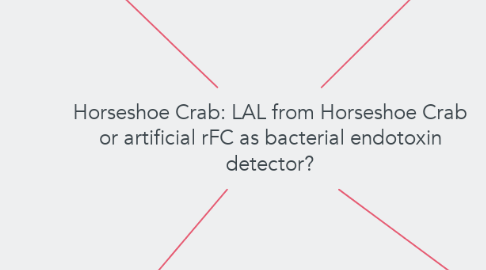
1. Limulus Amoebocyte Lysate (LAL)
1.1. Lyophilised preparation made from Horseshoe Crab amoebocytes (blood cells)
1.2. Detection Mechanism
1.2.1. Endotoxin initiates a cascade of enzyme activity that turn blood into gel clot
1.3. Physiological Function
1.3.1. As part of primitive immune system to limit bacteria invasion
1.4. LAL Test Production
1.4.1. Blood extraction from Horseshoe Crab required
1.4.2. Lysed amoebocytes as LAL reagent
1.5. Ecological Value
1.5.1. Reasearch in animal evolution
1.5.2. As a food source for birds
1.5.3. Endangered species
1.6. Harvesting
1.6.1. Overharvesting
1.6.1.1. High mortality rate
1.6.1.2. Reduced ability to survive
1.6.1.2.1. reeduce in population
1.7. Pros
1.7.1. Relatively lower cost
1.7.2. Higher accuracy
1.7.3. Lower purity due to other blood components
1.8. Cons
1.8.1. Complex Mechanism
1.8.1.1. Higher variation
1.8.2. Ecological impact
2. Significance of Horseshoe Crab to Academic Research
2.1. Chemistry
2.1.1. Fluorescence in the rFC mechanism
2.1.2. Combination of Factor B,C and G in LAL to form the LAL reagent
2.1.3. Chemical reactions between LAL reagent and bacterial endotoxin
2.2. Evolutionary Biology
2.2.1. Considered "living fossils" - existed nearly unchanged for at least 445 million years
2.3. Biotechnology
2.3.1. Synthetic replacement for LAL by recombinant protein synthesis which produces Recombinant Factor C
2.4. Ecology
2.4.1. Keystone species in Atlantic and gulf coasts of North America
2.4.2. Bioturbator and food source for shorebirds, fish and crustaceans
2.4.3. Predator of mollusks and polychaete worms
2.5. Medical Science
2.5.1. Its blood contains LAL, used to test medical instruments, implants and some pharmaceuticals
3. Recombinant Factor C (rFC)
3.1. Synthetic Replacement of LAL
3.2. Method
3.2.1. Recombinant Protein Synthesis
3.2.2. Endotoxin activates Factor C which trigger the turnover of a fluorogenic substrate
3.3. Pros
3.3.1. Can produce unlimited amounts of rFC
3.3.2. Does not involve harming animals
3.3.3. Simple mechanism
3.3.3.1. Lower variations
3.3.4. High purity
3.3.4.1. High specificity
3.4. Cons
3.4.1. Expensive production cost
3.4.2. Relatively lower accuracy than LAL
